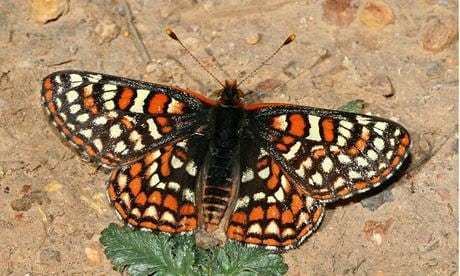Scientific name Euphydryas editha quino Rank Subspecies | ||
 | ||
Similar Butterfly, Bay checkerspot butterfly, Edith's checkerspot, Euphydryas, Insect | ||
The endangered quino checkerspot butterfly
The Quino checkerspot (Euphydryas editha quino) is native to southern California and northwestern Mexico. It is a subspecies of the common Edith's checkerspot (Euphydryas editha) and the second such subspecies to be listed under the federal Endangered Species Act. This species, like many others, has undergone several changes in nomenclature and classification. It was originally described as Melitaea quino in 1863 and then in 1929 it was reduced to a subspecies of Euphydryas chalcedona. In 1998 it was concluded through Behr's 1863 description that it should be classified as E. editha, not E. chalcedona. The species was synonymous with E. editha wrighti, a junior synonym for E. e. quino, thus becoming scientifically accepted as E. editha quino.
Contents
- The endangered quino checkerspot butterfly
- The quino checkerspot captive breeding technique
- Appearance
- Life cycle
- Habitat
- Range
- References

The quino checkerspot captive breeding technique
Appearance

A member of the brush-foot butterfly family, Nymphalidae, the Quino checkerspot is a medium-sized butterfly with a wingspan of around 3 cm. The dorsal wing surface are a colorful checkerboard of brown, red and yellow spots. The Quino differs from other E. editha subspecies in that its spots tend to be a darker red.
It also differentiates itself through its size and larval and pupal phenotypes. The ventral side of the butterfly are dominated by a checkered red and cream pattern. Its abdomen has red stripes across the dorsal side. After a second molt, the Quino checkerspot is recognized by the dark black coloration and row of 8 to 9 orange tubercles on their back. Before the larvae first molt they are mostly a yellowish color. After first molt and before their second molt they are gray with black markings. The pupae are mottled black on a bluegray background.

The Quino checkerspot is easily confused in the field by inexperienced butterfly searchers. It is generally confused with three other co-occurring butterfly species, the chalcedon or variable checkerspot, (Euphydryas chalcedona), Gabb's checkerspot (Chlosyne gabbii) and Wright's checkerspot (Thessalia leonira wrighti).
Life cycle
The life cycle of the Quino checkerspot closely mirrors that of the close Bay checkerspot. They share the same host plant and similar chronology of developmental stages.
Habitat
The obvious factor in the decline of the Quino checkerspot is urban development. Much of the historic scrub land that it occupied, much like the mission blue butterfly, also endangered, has been built over. The persisting habitat faces other threats. Invasive species, in the form of non native plant life and over grazing are just two of the hurdles facing the recovery of the Quino checkerspot. Today, there are 8 populations of the Quino known.
Range
Habitat declined and, thus, distribution and population of the Quino checkerspot has been greatly reduced during the last 100 years. Nearly all of the blame lie in agricultural and urban development in southern California. The other impactors to the decline include non native grasses and fire suppression practices as well as grazing. The Quino checkerspot became the second subspecies of Euphydryas editha to be listed under the Endangered Species Act (ESA). The first was the Bay checkerspot.
Currently, the Quino checkerspot is only found in a very few locales. Western Riverside County, southern San Diego County and northern Baja California, Mexico. The animal's historic range once included much of coastal California south of Ventura County as well as the inland valleys south of the Tehachapi Mountains. Regardless, more than 75% of the butterfly's original range has been lost. The range loss translates directly into population decline. Quino checkerspot butterfly populations appear to have decreased by more than 95% range-wide.
